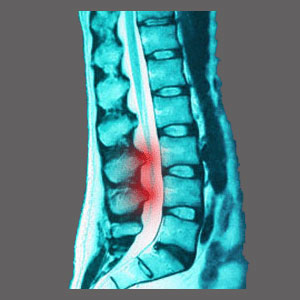
There are universally expected causes of lumbar spinal stenosis and incidental, case-specific sources, as well. Minor lumbar central canal narrowing is typical to experience as we age, and luckily, is not overly problematic to any large degree in the vast majority of people. However, circumstances can create symptomatic versions of lumbar spinal stenosis in some patients, potentially enacting dire expressions of pain and neurological impairment.
This article will detail the many possible causes and contributors to normal and symptomatic varieties of stenotic change in the lower spinal regions. We will investigate why some patients experience pain, while others do not demonstrate any symptoms whatsoever.
Expected Causes of Lumbar Spinal Stenosis
The degenerative processes which act on our spines universally are most active in the lumbar region. These process include:
Degenerative disc disease and subsequent intervertebral herniation can reduce the patency of the central canal. Intervertebral disc pathologies found in the lumbar region are the most common of all disc abnormalities in the human spine.
Hypertrophic changes in the ligamentum flavum are also commonplace and can further reduce available space in the spinal canal. Ligament inflammation is also typically seen in the lower lumbar area.
Osteoarthritis will likely be present and will cause bone spurs and arthritic debris to form around the facet joints, within the neuroforaminal spaces and inside the central canal. These are some of the most difficult changes to deal with, since they are usually considered permanent, unlike the above soft tissue pathologies which may be classified as transitory.
These processes might be found throughout the lumbar spine, but are most notable between L4 and S1.
Case-Specific Causes of Lumbar Stenosis
The following conditions can also reduce the effective size of the central canal, but are not universal or expected in the general population:
Lumbar spondylolisthesis can definitely compromise the central and foraminal canal spaces. When a vertebra migrates out of typical alignment, the central and foraminal canals will not line up correctly, possibly significantly reducing their patency.
Scoliosis can affect the alignment and viability of the central canal. Fortunately, lumbar scoliosis is not the most common location for this irregular side to side curvature to occur.
Severe hyperlordotic change can also decrease the space within the spinal canal. The same process can affect the alignment of the foraminal openings, as well. Rarely, extreme hypolordosis can also enact similar changes.
Back injury can have many possible consequences which may result in a less patent central spinal canal.
A congenitally narrowed spinal canal may be mildly to severely narrowed from birth. In these circumstances, any additional factors which reduce the canal space will have an increased chance of enacting symptoms.
Summary of Causes of Lumbar Spinal Stenosis
In almost every case, the worst examples of lumbar stenosis are located between L4 and S1. Upper lumbar levels usually do not demonstrate the same degree of deterioration or propensity for injury as the lower levels. In these lower spinal levels, the spinal cord has already transitioned into the cauda equina. This means that central stenosis may affect one or more of the separated nerve roots, possibly enacting the terrible condition known as cauda equina syndrome.
Just remember that mild to moderate stenosis is virtually universal near the lumbosacral juncture as we get older. Most cases will not cause pain or nerve symptoms, but some might. Additionally, since cervical spinal stenosis is also commonplace in the elderly, patients must be very careful to seek expert evaluation from a neurologist if they are ever diagnosed with lumbar stenotic change.
In many patients, the lumbar canal changes are innocent and treatment begins unnecessarily. Meanwhile, the cervical canal narrowing is the true source of symptoms and remains undiscovered, and therefore, untreated. Be wary.
Spinal Stenosis > Lumbar Spinal Stenosis > Causes of Lumbar Spinal Stenosis





